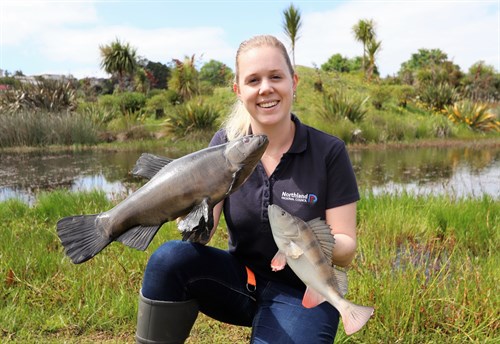Biodiversity experts are pleased with the public response to a survey that will help steer future management options for invasive weeds and exotic fish in Northland’s lakes, ponds and dams.
The Northland Regional Council (NRC) and the National Institute of Water and Atmospheric Research (NIWA) already regularly monitor more than100 regional lakes and have good biological data on them.
However, the council was keen to know more about another 372 lakes, ponds or dams – all bigger than 0.5 hectares. To that end, it had earlier this year written to the hundreds of owners of the properties the waterbodies sit on asking for their help.
Council chairman Bill Shepherd says he’s delighted with the public feedback, with just over a third of those written to replying.
“We received a total of 141 responses (36.72%) from 121 individual landowners, covering 143 of the 372 waterbodies we’re interested in, which is a good response rate for a survey of this kind.” (The survey excluded the 100 regularly monitored lakes.)
“We really appreciate the time and effort responders have put into this process as these results will be important in steering future management options for exotic invasive weeds and fish.”
Brooke Hartigan, the council’s Biodiversity Advisor – Lakes, shared Chairman Shepherd’s sentiments about the public feedback, adding the survey had identified some key conclusions about the water bodies involved and resulted in more than a dozen recommendations.
The latter included fish removal, training on invasive fish for interested landowners and community members, plans for a public awareness campaign, new signage and development of new educational tools for young people.
“Creation of a Freshwater Pests Pathways Management Plan or site-based plans for invasive fish and water-weeds has also been recommended.”
Among the survey’s key findings were the discovery of three new records of invasive pest fish species, now being investigated with a view to further action, including removal. (While a number of other invasive fish were also reported, their presence was already known to either the council, Department of Conservation or Fish and Game staff.)
She says eight dune lakes classed as ecologically ‘high’ or ‘outstanding’ (or near to a lake with those rankings) have also been prioritised to have exotic fish removed from them.
Ms Hartigan says survey participants named egeria (oxygen weed) as the most frequently encountered weed, while gambusia and rudd were the most common fish reported.
Duck hunting was the most common lake use, with 42.25% of respondents naming it as a past or current activity at their waterbody.
“The use of pumps, hoses and tanks in or around waterbodies was the next common use (41.30%), then kayaks, canoes and dinghies (25.36%) followed closely by eel fishing (24.64%).”
Ms Hartigan says different lake use rankings were related to lakes with just weeds present or just fish present.
“Where weeds were present in waterbodies, duck hunting (24.24%), kayaks, canoes and dinghies (24.24%) and pumps, tanks and hoses (18.18%) were the most common lake uses.”
However, where exotic fish were present, kayaks, canoes and dinghies (54.55%), duck hunters (45.45%) and eel fishers (36.36%) were the most common lake uses.
“These results will be important in the future with the implementation of our public engagement campaign.”
Chairman Shepherd says more information about the survey is available online via: www.nrc.govt.nz/fishandweedsurvey

Regional council Biodiversity Advisor Brooke Hartigan at Whangarei’s Dragonfly Springs; one of the waterbodies included in the NRC’s exotic fish and water-weed survey. She’s holding fibreglass mounts of a tench (the larger fish) and a perch; both unwanted pest species.
